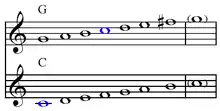Common tone (scale)
In music, a common tone is a pitch class that is a member of, or common to (shared by) two or more scales or sets.

Common tone theorem

A common tone is a pitch class that is a member of, or common to, a musical scale and a transposition of that scale, as in modulation (Johnson 2003, p. 42). Six of seven possible common tones are shared by closely related keys, though keys may also be thought of as more or less closely related according to their number of common tones. "Obviously, tonal distance is in some sense a function of the extent of intersection between diatonic PC collections of tonal systems" (Berry 1987, p. 80).
| Diatonic transposition |
0 | 1/e | 2/t | 3/9 | 4/8 | 5/7 | 6/6 |
|---|---|---|---|---|---|---|---|
| Common tones | 7 | 2 | 5 | 4 | 3 | 6 | 1 |
In diatonic set theory the common tone theorem explains that scales possessing the deep scale property share a different number of common tones, not counting enharmonic equivalents (for example, C♯ and C♭ have no common tones with C major), for every different transposition of the scale. However many times an interval class occurs in a diatonic scale is the number of tones common both to the original scale and a scale transposed by that particular interval class. For example, then, modulation to the dominant (transposition by a perfect fifth) includes six common tones between the keys as there are six perfect fifths in a diatonic scale, while transposition by the tritone includes only one common tone as there is only one tritone in a diatonic scale (Johnson 2003, p. 42).

| Key | IC | CT | Notes common with C | ||||||
|---|---|---|---|---|---|---|---|---|---|
| C | 0 | NA | C | D | E | F | G | A | B |
| B | 1 | 2 | E | B | |||||
| D♭ | C | F | |||||||
| D | 2 | 5 | D | E | G | A | B | ||
| B♭ | C | D | F | G | A | ||||
| A | 3 | 4 | D | E | A | B | |||
| E♭ | C | D | F | G | |||||
| E | 4 | 3 | E | A | B | ||||
| A♭ | C | F | G | ||||||
| G | 5 | 6 | C | D | E | G | A | B | |
| F | C | D | E | F | G | A | |||
| F♯ | 6 | 1 | B | ||||||
| G♭ | F | ||||||||
Deep scale property



In diatonic set theory, the deep scale property is the quality of pitch class collections or scales containing each interval class a unique number of times. Examples include the diatonic scale (including major, natural minor, and the modes) (Johnson 2003, p. 41). In twelve-tone equal temperament, all scales with the deep scale property can be generated with any interval coprime with twelve (Johnson 2003, p. 83).
For example, the diatonic scale's interval vector contains:
| PC | 1 | 2 | 3 | 4 | 5 | 6 |
|---|---|---|---|---|---|---|
| Occurrence | 2 | 5 | 4 | 3 | 6 | 1 |
The common tone theorem describes that scales possessing the deep scale property share a different number of common tones for every different transposition of the scale, suggesting an explanation for the use and usefulness of the diatonic collection (Johnson 2003, p. 42).
In contrast, the whole tone scale's interval vector contains:
| PC | 1 | 2 | 3 | 4 | 5 | 6 |
|---|---|---|---|---|---|---|
| Occurrence | 0 | 6 | 0 | 6 | 0 | 3 |
and has only two distinct transpositions (every even transposition of the whole tone scale is identical with the original and every odd transposition has no common tones whatsoever).
References
- Berry, Wallace (1987). Structural Functions in Music. New York: Dover. 2nd ed. ISBN 0-486-25384-8.
- Johnson, Timothy A. (2003). Foundations of Diatonic Theory: A Mathematically Based Approach to Music Fundamentals. Mathematics Across the Curriculum. Emeryville, CA: Key College Publishing. ISBN 978-1-930190-80-1. LCCN 2002075736.CS1 maint: ref=harv (link)
Further reading
- Browne, Richmond (1981). "Tonal Implications of the Diatonic Set" In Theory Only 5, nos. 6–7:6–10.
- Douthett, Jack Moser, Martha M. Hyde, and Charles J. Smith, eds. (2008). Music Theory and Mathematics. Eastman Studies in Music. Rochester, NY: University of Rochester Press. ISBN 9781580462662.
- Gamer, Carlton (1967). "Deep Scales and Difference Sets in Equal-Tempered Systems", American Society of University Composers: Proceedings of the Second Annual Conference: 113-22 and "Some Combinational Resources of Equal-Tempered Systems", Journal of Music Theory 11: 32-59.
- Winograd, Terry. "An Analysis of the Properties of 'Deep Scales' in a T-Tone System", unpublished.